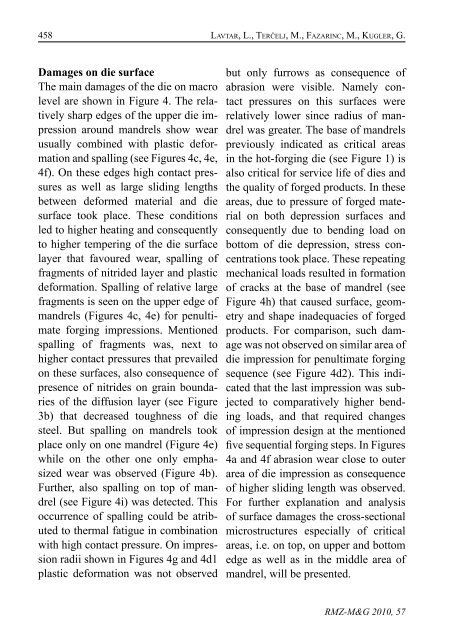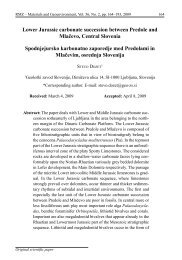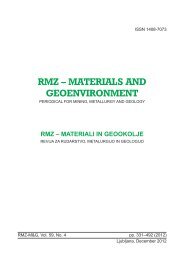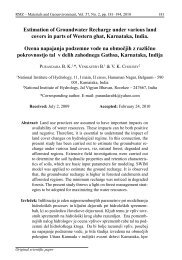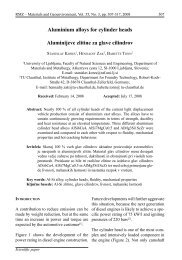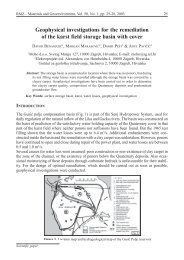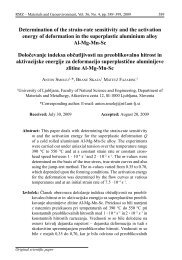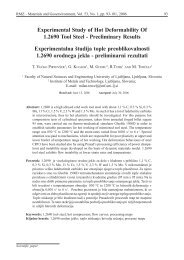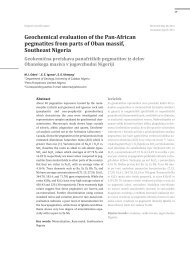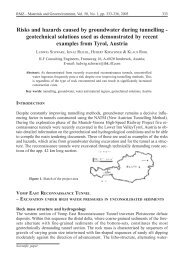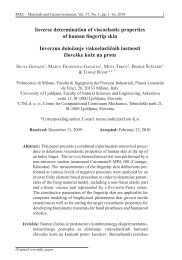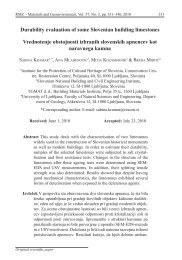Main damages on upper die in industrial hot forging Glavne ... - RMZ
Main damages on upper die in industrial hot forging Glavne ... - RMZ
Main damages on upper die in industrial hot forging Glavne ... - RMZ
Create successful ePaper yourself
Turn your PDF publications into a flip-book with our unique Google optimized e-Paper software.
458 Lavtar, L., Terčelj, M., Fazar<strong>in</strong>c, M., Kugler, G.Damages <strong>on</strong> <strong>die</strong> surfaceThe ma<strong>in</strong> <str<strong>on</strong>g>damages</str<strong>on</strong>g> of the <strong>die</strong> <strong>on</strong> macrolevel are shown <strong>in</strong> Figure 4. The relativelysharp edges of the <strong>upper</strong> <strong>die</strong> impressi<strong>on</strong>around mandrels show wearusually comb<strong>in</strong>ed with plastic deformati<strong>on</strong>and spall<strong>in</strong>g (see Figures 4c, 4e,4f). On these edges high c<strong>on</strong>tact pressuresas well as large slid<strong>in</strong>g lengthsbetween deformed material and <strong>die</strong>surface took place. These c<strong>on</strong>diti<strong>on</strong>sled to higher heat<strong>in</strong>g and c<strong>on</strong>sequentlyto higher temper<strong>in</strong>g of the <strong>die</strong> surfacelayer that favoured wear, spall<strong>in</strong>g offragments of nitrided layer and plasticdeformati<strong>on</strong>. Spall<strong>in</strong>g of relative largefragments is seen <strong>on</strong> the <strong>upper</strong> edge ofmandrels (Figures 4c, 4e) for penultimateforg<strong>in</strong>g impressi<strong>on</strong>s. Menti<strong>on</strong>edspall<strong>in</strong>g of fragments was, next tohigher c<strong>on</strong>tact pressures that prevailed<strong>on</strong> these surfaces, also c<strong>on</strong>sequence ofpresence of nitrides <strong>on</strong> gra<strong>in</strong> boundariesof the diffusi<strong>on</strong> layer (see Figure3b) that decreased toughness of <strong>die</strong>steel. But spall<strong>in</strong>g <strong>on</strong> mandrels tookplace <strong>on</strong>ly <strong>on</strong> <strong>on</strong>e mandrel (Figure 4e)while <strong>on</strong> the other <strong>on</strong>e <strong>on</strong>ly emphasizedwear was observed (Figure 4b).Further, also spall<strong>in</strong>g <strong>on</strong> top of mandrel(see Figure 4i) was detected. Thisoccurrence of spall<strong>in</strong>g could be atributedto thermal fatigue <strong>in</strong> comb<strong>in</strong>ati<strong>on</strong>with high c<strong>on</strong>tact pressure. On impressi<strong>on</strong>radii shown <strong>in</strong> Figures 4g and 4d1plastic deformati<strong>on</strong> was not observedbut <strong>on</strong>ly furrows as c<strong>on</strong>sequence ofabrasi<strong>on</strong> were visible. Namely c<strong>on</strong>tactpressures <strong>on</strong> this surfaces wererelatively lower s<strong>in</strong>ce radius of mandrelwas greater. The base of mandrelspreviously <strong>in</strong>dicated as critical areas<strong>in</strong> the <strong>hot</strong>-forg<strong>in</strong>g <strong>die</strong> (see Figure 1) isalso critical for service life of <strong>die</strong>s andthe quality of forged products. In theseareas, due to pressure of forged material<strong>on</strong> both depressi<strong>on</strong> surfaces andc<strong>on</strong>sequently due to bend<strong>in</strong>g load <strong>on</strong>bottom of <strong>die</strong> depressi<strong>on</strong>, stress c<strong>on</strong>centrati<strong>on</strong>stook place. These repeat<strong>in</strong>gmechanical loads resulted <strong>in</strong> formati<strong>on</strong>of cracks at the base of mandrel (seeFigure 4h) that caused surface, geometryand shape <strong>in</strong>adequacies of forgedproducts. For comparis<strong>on</strong>, such damagewas not observed <strong>on</strong> similar area of<strong>die</strong> impressi<strong>on</strong> for penultimate forg<strong>in</strong>gsequence (see Figure 4d2). This <strong>in</strong>dicatedthat the last impressi<strong>on</strong> was subjectedto comparatively higher bend<strong>in</strong>gloads, and that required changesof impressi<strong>on</strong> design at the menti<strong>on</strong>edfive sequential forg<strong>in</strong>g steps. In Figures4a and 4f abrasi<strong>on</strong> wear close to outerarea of <strong>die</strong> impressi<strong>on</strong> as c<strong>on</strong>sequenceof higher slid<strong>in</strong>g length was observed.For further explanati<strong>on</strong> and analysisof surface <str<strong>on</strong>g>damages</str<strong>on</strong>g> the cross-secti<strong>on</strong>almicrostructures especially of criticalareas, i.e. <strong>on</strong> top, <strong>on</strong> <strong>upper</strong> and bottomedge as well as <strong>in</strong> the middle area ofmandrel, will be presented.<strong>RMZ</strong>-M&G 2010, 57


